Top Providers of Global Call Center Solutions

Leading providers of global call center solutions for 2025 include Sobot, Nextiva, Talkdesk, Dialpad, and RingCentral. Sobot stands out with its all-in-one omnichannel approach and powerful Sobot AI, which drives business growth and global expansion through advanced automation. The Sobot call center platform helps businesses scale quickly, enhance customer experience, and boost satisfaction. Cloud-based solutions like Sobot offer flexibility and cost efficiency. Choosing the right Sobot call center solution supports business growth and ensures smooth operations.
Global Call Center Solutions Overview
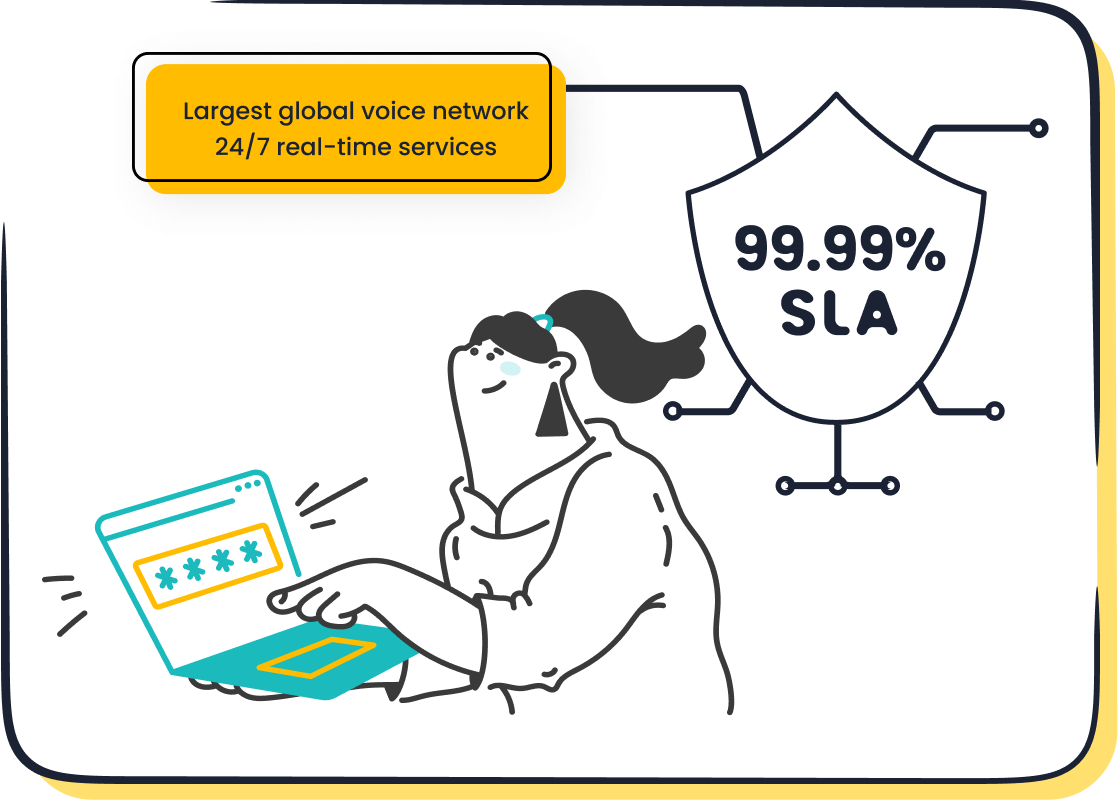
What Are Global Call Center Solutions
Global call center solutions help businesses manage customer interactions across different regions and channels. These solutions use advanced call center software to connect agents with customers through phone, email, chat, and social media. Companies rely on call center software solutions to streamline communication, improve response times, and deliver consistent service worldwide. Key components include:
- VoIP software interfaces that let agents handle calls using computers.
- Cloud hosting for secure data storage and remote access.
- Advanced call routing that matches customers with the right agent.
- Integration with CRM and AI systems for real-time customer data and automation.
These features make global call center solutions flexible, scalable, and cost-effective. Businesses can support customers in multiple languages and regions, ensuring high-quality service at every touchpoint.
Key Trends in 2025
The call center software market is growing rapidly. In 2025, experts estimate the market will reach $63.92 billion, with a projected annual growth rate of 19.7% through 2032.
| Market Segment | Estimated Size in 2025 (USD) | Projected Size in 2032 (USD) | CAGR (%) (2025-2032) |
|---|---|---|---|
| Call Center Software Market | 63.92 billion | 225.06 billion | 19.7 |
Several trends drive this growth:
- AI and automation handle routine tasks and speed up responses.
- Cloud-based solutions allow instant scaling and remote work.
- Omnichannel support integrates all communication channels for a seamless experience.
- Real-time language translation and predictive analytics improve personalization and efficiency.
Why Omnichannel Support Matters
Omnichannel support connects all customer communication channels into one unified journey. Customers can switch from chat to phone without repeating information. This approach reduces frustration and increases satisfaction. Companies with strong omnichannel support see customer retention rates as high as 89%, compared to only 33% for those with weak strategies. Omnichannel communication gives agents a complete view of each customer’s history, enabling faster and more personalized service. This integration builds trust, improves first contact resolution, and keeps customers loyal.
Types of Call Center Software Solutions
Cloud vs. On-Premise
Businesses today face a key decision when selecting call center software solutions: cloud-based or on-premise. Cloud-based solutions offer flexibility and lower upfront costs, while on-premise systems require significant investment in hardware and IT resources. The following table highlights the main differences:
| Aspect | On-Premise Call Center | Cloud-Based Call Center |
|---|---|---|
| Cost | High upfront costs for hardware, licenses, and ongoing maintenance. | Subscription-based pricing with pay-as-you-go model, minimal upfront investment. |
| Scalability | Slow and costly; requires purchasing and installing new hardware. | Easily scalable by adding users and features without hardware upgrades. |
| Reliability | Prone to downtime due to local outages and hardware failures; requires dedicated IT staff for maintenance. | Higher uptime with geographic redundancy and vendor-managed maintenance, minimizing downtime. |
| Maintenance & IT | Requires dedicated IT staff and ongoing repair/support costs. | Maintenance handled by provider, reducing internal IT burden and operational costs. |
Cloud contact center platforms allow companies to scale quickly and adapt to changing needs. Cloud call center systems also provide higher reliability, as vendors manage maintenance and updates. Many organizations choose cloud-based solutions to reduce costs and improve business agility.
Inbound and Outbound Capabilities
Call center software solutions support both inbound and outbound operations. Inbound centers handle customer queries and support requests, aiming for quick responses and high satisfaction. Outbound centers focus on sales, lead generation, and customer feedback. Both types use contact center software to optimize agent performance and monitor key metrics.
- Inbound centers improve customer satisfaction through fast response times and first-call resolution.
- Outbound centers drive business growth by reaching out to customers for sales and feedback.
- Hybrid centers combine both functions, offering flexibility and better workforce utilization.
- Advanced call center software uses intelligent call routing and analytics to reduce wait times and improve efficiency.
Contact center software tracks important metrics like average handle time, call abandonment rate, and conversion rate. These insights help managers balance call volume and quality, ensuring effective operations.
AI and Automation in Contact Center Software
AI and automation have transformed contact center software. These technologies automate routine tasks, such as answering FAQs and managing appointments, freeing agents to focus on complex issues. AI-powered contact center software delivers personalized, 24/7 support, reducing wait times and improving customer satisfaction.
- Intelligent call routing directs inquiries to the most qualified agents, increasing first contact resolution.
- Automation decreases average handle time and boosts agent productivity.
- AI-driven analytics provide actionable insights for continuous improvement.
- Self-service options, like chatbots and virtual assistants, offer fast and accurate responses.
Contact center software solutions with AI and automation help businesses scale efficiently and reduce operational costs. These tools empower agents, improve service quality, and enhance the overall customer experience.
Essential Features of Contact Center Software
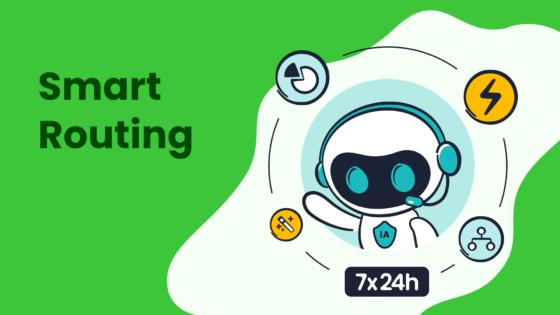
Omnichannel Support and Integration
Omnichannel support stands as a cornerstone of modern contact center software. Businesses request features that unify all customer interactions into a single agent workspace, providing a 360° customer profile for personalized service. Multi-channel support covers voice, email, chat, social media, and SMS, ensuring customers can reach out through their preferred method. Seamless CRM integration with platforms like Salesforce enables automatic syncing of customer data, screen pops for incoming calls, and click-to-dial functionality. AI-driven tools such as IVR and automatic call distribution enhance routing and efficiency. These capabilities drive workforce optimization, improve agent performance, and boost satisfaction by delivering consistent service across every channel.
Analytics and Reporting
Advanced analytics and reporting transform raw data into actionable insights. Contact center software consolidates metrics like average wait time, first call resolution, and satisfaction into dashboards. Managers use these insights to identify trends, optimize staffing, and address performance gaps. Real-time analytics allow supervisors to intervene quickly, supporting workforce optimization and improving agent performance. Predictive analytics forecast call volume, helping allocate resources efficiently. Speech and text analytics reveal customer sentiment and common issues, guiding targeted training and process improvements. These features empower organizations to enhance customer experience and retention.
Security and Compliance
Security and compliance remain critical for global contact center software providers. Strict access controls, two-factor authentication, and zero-trust security models protect sensitive data. Compliance with standards such as PCI DSS, HIPAA, TCPA, and GDPR ensures data privacy and regulatory adherence. Encryption, firewalls, and regular audits further strengthen security. Agent training and consent management for call recording help maintain compliance. These measures reduce business risks, protect customer trust, and support operational integrity.
Scalability and Global Reach
Scalability and global reach define leading contact center software. Cloud-based architecture enables flexible scaling, supporting remote and hybrid teams. Omnichannel support integrates global customer interactions, while AI-powered features like intelligent routing and real-time analytics streamline operations. Providers offer global phone numbers, multi-language support, and real-time data interpretation. Flexible APIs and hybrid deployment options allow businesses to expand without compromise. These features ensure organizations can deliver high-quality service and performance insights worldwide.
Leading Providers of Global Call Center Solutions
Choosing the right call center software solutions can transform customer experience, drive operational efficiency, and support global business growth. In 2025, several providers stand out for their innovation, scalability, and advanced features. This section compares the top call center solutions: Sobot, Nextiva, Talkdesk, Dialpad, and RingCentral. Each provider offers unique models, pricing models, and capabilities tailored to different business needs.
Sobot: All-in-One Omnichannel Solution
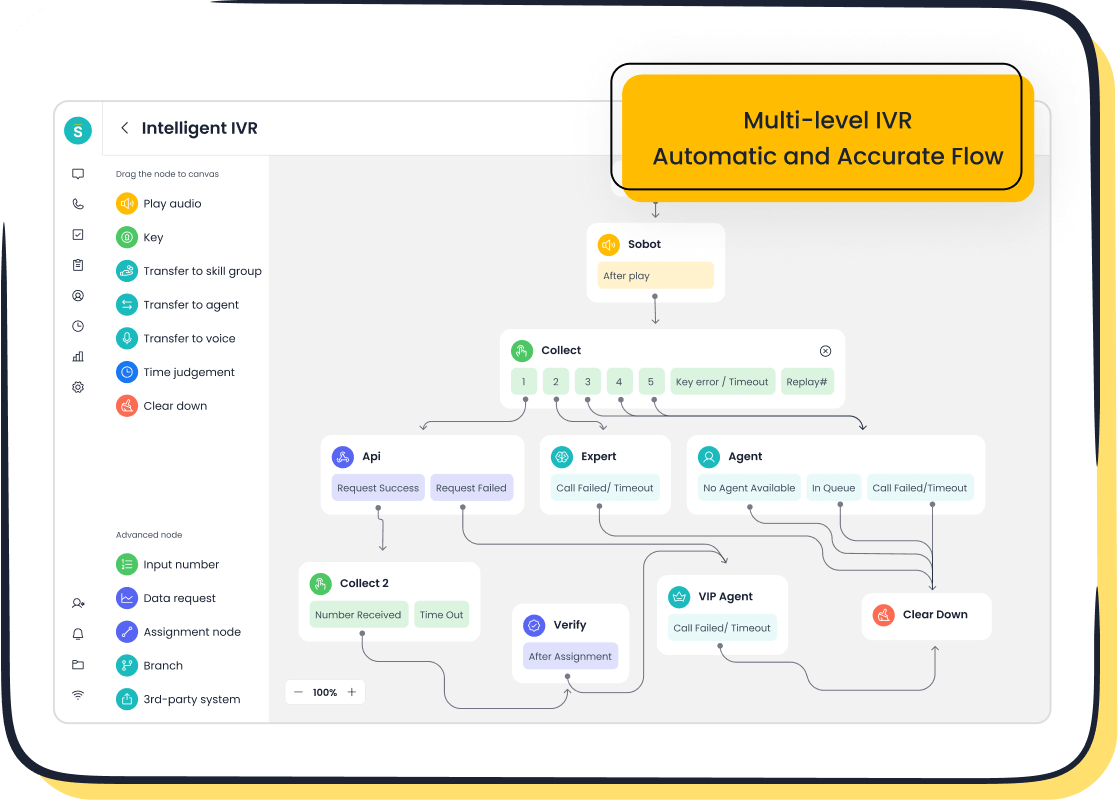
Sobot has emerged as one of the best call center software providers for global enterprises seeking integrated, intelligent, and scalable solutions. The platform supports seamless customer interactions across channels such as WhatsApp, Meta, Instagram, Telegram, and more. Sobot’s product suite includes AI Chatbot, Live Chat, Voice, Ticketing, and WhatsApp Business API, all unified in a single workspace.
Standout Features:
- Sobot’s omnichannel model enables businesses to manage customer conversations from multiple platforms in one place.
- The AI Agent leverages advanced NLP and LLM technologies to deliver fast, accurate, and human-like multilingual responses.
- The platform integrates with major cloud providers like AWS and Alibaba Cloud, enhancing reliability and scalability.
- Open APIs connect call center and ticketing systems, reducing waiting times by up to 35% in real deployments.
- Marketing enablement features allow two-way customer interaction, boosting engagement and loyalty.
- Sobot’s upgraded AI Agent extends capabilities to voice calling and email ticketing, supporting international operations without extra knowledge base adjustments.
- The AI Agent autonomously manages knowledge base content, reducing maintenance workload by up to 90%.
- Performance improvements include a 15%-35% increase in direct response rate and a 5%-15% increase in answer accuracy.
Customer Success Stories:
- Samsung, OPPO, Renogy, and other global brands trust Sobot for their call center software solutions.
- Samsung achieved a 97% customer satisfaction rate and a 30% increase in agent efficiency after deploying Sobot’s omnichannel platform.
- Renogy reported a 35% increase in direct response rate and a 27% increase in answer accuracy with Sobot’s AI Agent.
Pricing Models:
- Sobot offers flexible SaaS-based contact center pricing models, allowing businesses to scale up or down as needed.
- Pricing depends on the number of agents, channels, and advanced features selected.
- The platform provides transparent billing and no hidden fees, making budgeting straightforward.
Pros:
- Comprehensive omnichannel support.
- Advanced AI-powered automation.
- Global scalability and multilingual capabilities.
- Strong customer success and onboarding services.
Best-Fit Business Types:
- Enterprises with global operations.
- Retail, financial services, gaming, education, and life services.
- Organizations seeking unified customer experience and high agent productivity.
Sobot’s commitment to innovation and customer-centricity positions it among the top call center solutions for 2025.
Learn more: Sobot Official Website
Nextiva: Unified Communications Platform
Nextiva ranks among the leading providers of call center software solutions, offering a unified communications platform that integrates all customer interactions into a single AI-powered system. The Unified-CXM platform orchestrates customer journeys and streamlines workflows.
Standout Features:
- Nextiva Unified-CXM combines real-time video conferencing, chat, SMS, and contact center capabilities over the internet.
- AI-driven features include generative AI knowledge bases, secure payment agent assist, and automated call dispositioning.
- Intelligent routing uses situation and skill-based algorithms, robust ACD, and in-queue sidebars.
- Journey orchestration tools support supervisory outreach, workflow engines, and bot-to-agent-to-bot transitions.
- Advanced analytics provide real-time dashboards, customizable widgets, and generic query reports.
- The architecture supports disaster recovery, no maintenance windows, and seamless API integrations.
Pricing Models:
- Nextiva offers subscription-based contact center pricing models, with packages tailored to business size and needs.
- Pricing includes all-in-one access to unified communications features, reducing the need for additional hardware or software development.
- Businesses can select plans based on agent count, channels, and advanced AI capabilities.
Pros:
- All-in-one cloud-based solution.
- No technical skill required for setup.
- Robust AI and analytics features.
- Scalable for remote and hybrid teams.
Best-Fit Business Types:
- Medium to large enterprises.
- Organizations seeking unified communications and customer experience management.
- Businesses prioritizing remote work and seamless integration.
Nextiva’s platform simplifies complex customer journeys and enhances agent productivity through intelligent automation.
Talkdesk: Enterprise-Grade Contact Center Software
Talkdesk stands out as a provider of enterprise-grade call center software solutions, focusing on automation, customization, and security. The platform supports omnichannel communication and advanced analytics for large-scale deployments.
Standout Features: Talkdesk offers AI-powered automation tools, omnichannel analytics, and an intuitive Workspace interface. The platform includes advanced customer self-service options such as conversational AI and multi-level IVR. Over 60 out-of-the-box integrations support voice, live chat, email, SMS, and social media channels. Talkdesk’s Elite plan features custom reporting, advanced performance management, and premium add-ons like Agent Assist and Workforce Management. Experience Cloud packages cater to industries such as financial services, healthcare, retail, and government, providing specialized features and compliance tools.
Pricing Models: Talkdesk provides four scalable CX Cloud plans, ranging from $85 to $145+ per user per month. Industry-specific Experience Cloud packages and paid add-ons are available for specialized needs. The pricing model is transparent, with fewer add-on charges compared to competitors. Custom developments or additional features may increase costs, but overall, Talkdesk remains cost-effective for large enterprises.
Pros:
- Flexible automation-first solution.
- Robust security and compliance.
- Transparent contact center pricing models.
- Tailored packages for industry-specific requirements.
Best-Fit Business Types:
- Medium to large enterprises.
- Industries with complex compliance needs.
- Organizations requiring advanced customization and AI capabilities.
Talkdesk’s focus on automation and customization makes it one of the best call center software options for enterprises with demanding requirements.
Dialpad: AI-Driven Call Center Software
Dialpad has established itself as a leader among providers of AI-driven call center software solutions. The platform leverages proprietary AI models to enhance agent performance and customer interactions.
Standout Features:
- DialpadGPT, trained on over seven billion minutes of business conversations, powers context-aware AI capabilities.
- AI automates routine tasks, deflects common queries, and provides real-time guidance to agents.
- Managers benefit from AI Scorecards and performance dashboards for coaching and team management.
- Predictive customer behavior analysis and real-time response suggestions improve customer experience.
- Workforce management tools streamline scheduling and forecasting.
- Early adopters reported a 20% reduction in average handle time, 50% decrease in post-call work, and 10% drop in agent turnover.
- AI-powered features include Ai Agent, Ai Assistant, Ai Scorecards, Launchpad dashboard, and Dialpad WFM.
Pricing Models:
- Dialpad offers flexible contact center pricing models, including pay-as-you-go and tiered subscription plans.
- Pricing depends on agent count, channels, and selected AI features.
- Businesses can choose models that fit their operational scale and budget.
Pros:
- Advanced AI automation and analytics.
- Real-time assist and live coaching for agents.
- Streamlined workforce management.
- Transparent pricing models.
Best-Fit Business Types:
- Small to medium businesses.
- Enterprises seeking AI-powered automation.
- Organizations focused on improving agent efficiency and customer experience.
Dialpad’s AI-driven approach helps businesses stay competitive by automating tasks and providing actionable insights.
RingCentral: Flexible Cloud Call Center
RingCentral is recognized as one of the top call center solutions for businesses seeking flexibility and scalability. The cloud call center software supports diverse business models and remote workforces.
Standout Features:
- RingCentral’s solution requires only an internet connection and compatible device, enabling access from anywhere.
- Rapid scaling allows businesses to add or remove users quickly, accommodating growth or seasonal changes.
- Pay-as-you-go pricing models provide financial flexibility, avoiding costs for unused equipment or seats.
- Omnichannel capabilities, intelligent call routing, workforce management, call monitoring, built-in analytics, and AI-powered features are integrated into a unified dashboard.
- The cloud infrastructure supports virtual contact centers and remote teams across industries.
Pricing Models:
- RingCentral offers pay-as-you-go and subscription-based contact center pricing models.
- Businesses can select plans based on user count, channels, and advanced features.
- The flexible pricing models suit organizations with fluctuating needs.
Pros:
- Easy setup and remote access.
- Scalable for businesses of all sizes.
- Unified dashboard for managing all channels.
- Financial flexibility with pay-as-you-go models.
Best-Fit Business Types:
- Small businesses to large enterprises.
- Organizations with remote or hybrid teams.
- Companies needing rapid scaling and omnichannel support.
RingCentral’s cloud call center software solutions adapt to changing business needs, making it a reliable choice for diverse industries.
| Provider | Standout Features | Pricing Models | Best-Fit Business Types |
|---|---|---|---|
| Sobot | Omnichannel, AI Agent, global reach, open APIs, strong onboarding | SaaS-based, scalable, transparent | Global enterprises, retail, finance, gaming, education |
| Nextiva | Unified-CXM, AI orchestration, disaster recovery, analytics | Subscription-based, all-in-one | Medium/large enterprises, remote teams |
| Talkdesk | Automation, omnichannel analytics, industry packages | Tiered CX Cloud, Experience Cloud | Large enterprises, compliance-heavy industries |
| Dialpad | Proprietary AI, real-time assist, workforce management | Pay-as-you-go, subscription | SMBs, AI-focused organizations |
| RingCentral | Flexible cloud, rapid scaling, omnichannel dashboard | Pay-as-you-go, subscription | All sizes, remote/hybrid teams |
Tip: Evaluate each provider’s models, contact center pricing, and feature set to match your business needs and customer experience goals.
Comparison Table: Top Call Center Software Providers
Features and Integrations
Top call center software providers deliver a wide range of features and integrations. Sobot offers an all-in-one omnichannel solution, supporting voice, chat, ticketing, and WhatsApp API. The platform integrates with major CRM systems and provides open APIs for seamless workflow automation. Nextiva includes unified communications, built-in CRM, and AI-powered automation. Talkdesk focuses on AI-driven self-service, multi-channel digital tools, and extensive app integrations. Dialpad leverages proprietary AI for call summaries and agent assistance. NICE CXone provides advanced workforce optimization and real-time data analytics. These platforms enable businesses to unify customer interactions, automate routine tasks, and gain performance insights.
| Provider | Key Features | Integrations |
|---|---|---|
| Sobot | Omnichannel, AI Agent, open APIs | CRM, WhatsApp, SMS, Email |
| Nextiva | Unified-CXM, AI automation | CRM, VoIP, SMS |
| Talkdesk | AI self-service, app integrations | Voice, chat, analytics |
| Dialpad | Proprietary AI, call summaries | Meetings, CRM |
| NICE CXone | Workforce optimization, analytics | CRM, omnichannel |
Pricing and Value
Contact center pricing varies by provider, features, and business needs. Most platforms use subscription-based pricing models, charging per user monthly or annually. Sobot’s SaaS model offers transparent billing and scalability. Nextiva and Talkdesk provide tiered plans, with prices ranging from $85 to $199 per user per month. Dialpad starts at $15 and scales up with advanced features. NICE CXone offers seven plans, from $71 to $249 per user monthly. Annual billing often brings discounts. Providers also offer hybrid pricing models, combining fixed and variable elements for flexibility. Businesses should review pricing comparison tables and models to match their operational requirements.
| Provider | Pricing Range (per user/month) | Number of Plans | Contact Center Pricing Model |
|---|---|---|---|
| Sobot | Custom, scalable | Multiple | SaaS, subscription, transparent |
| Nextiva | $129 - $199 | 3 | Subscription, tiered |
| Talkdesk | $85 - $145+ | 3 + custom | Tiered, custom quotes |
| Dialpad | $15 - $150+ | Multiple | Subscription, pay-as-you-go |
| NICE CXone | $71 - $249 | 7 | Subscription, advanced tiers |
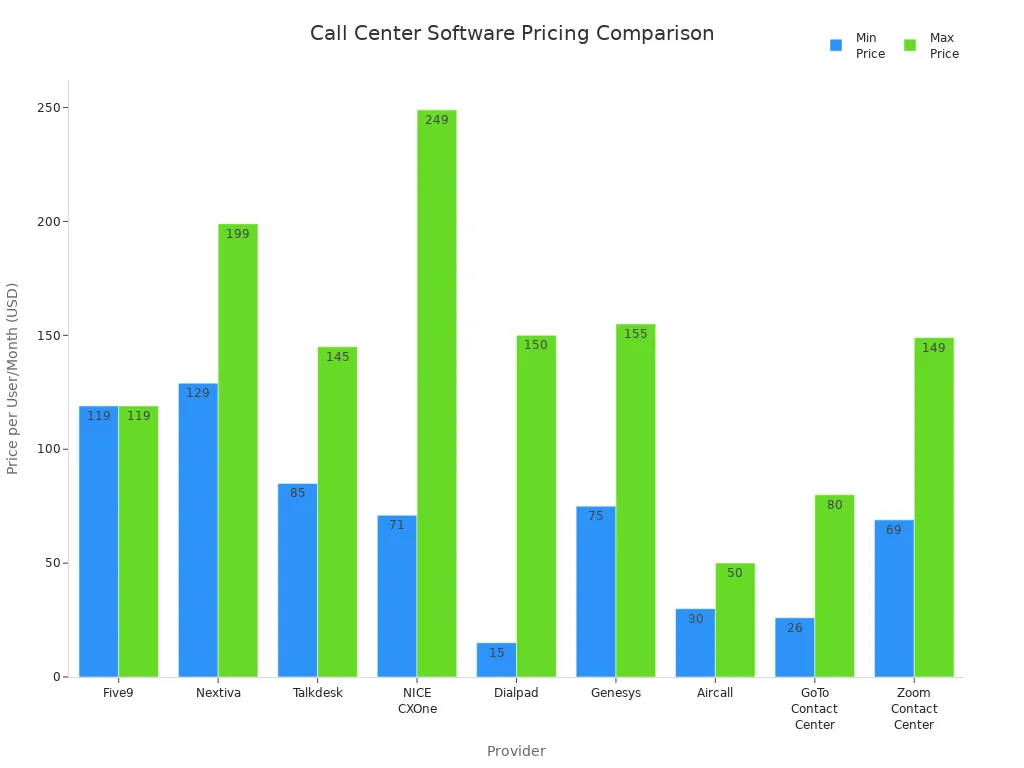
Tip: Subscription models offer predictable costs, while hybrid models provide customization for complex operations.
Best Use Cases
Each provider serves different business scenarios. Sobot excels in global enterprises needing unified omnichannel support and high agent productivity. Nextiva fits SMBs and larger organizations seeking integrated communications and journey orchestration. Talkdesk supports companies requiring AI-driven quality assurance and extensive integrations. Dialpad benefits businesses focused on AI automation and workforce management. NICE CXone suits large enterprises handling high-volume, global operations with advanced analytics.
| Call Center Software | Best Business Use Case | Key Features Supporting Use Case |
|---|---|---|
| Sobot | Global, omnichannel customer experience | Unified workspace, AI Agent, open APIs |
| Nextiva | SMB Customer Experience Management | Built-in CRM, AI automation, VoIP |
| Talkdesk | AI-driven Quality Assurance | Self-service, app integrations, security |
| Dialpad | AI-powered agent productivity | Proprietary AI, call summaries, meetings |
| NICE CXone | Large-scale, advanced analytics | Workforce optimization, real-time data |
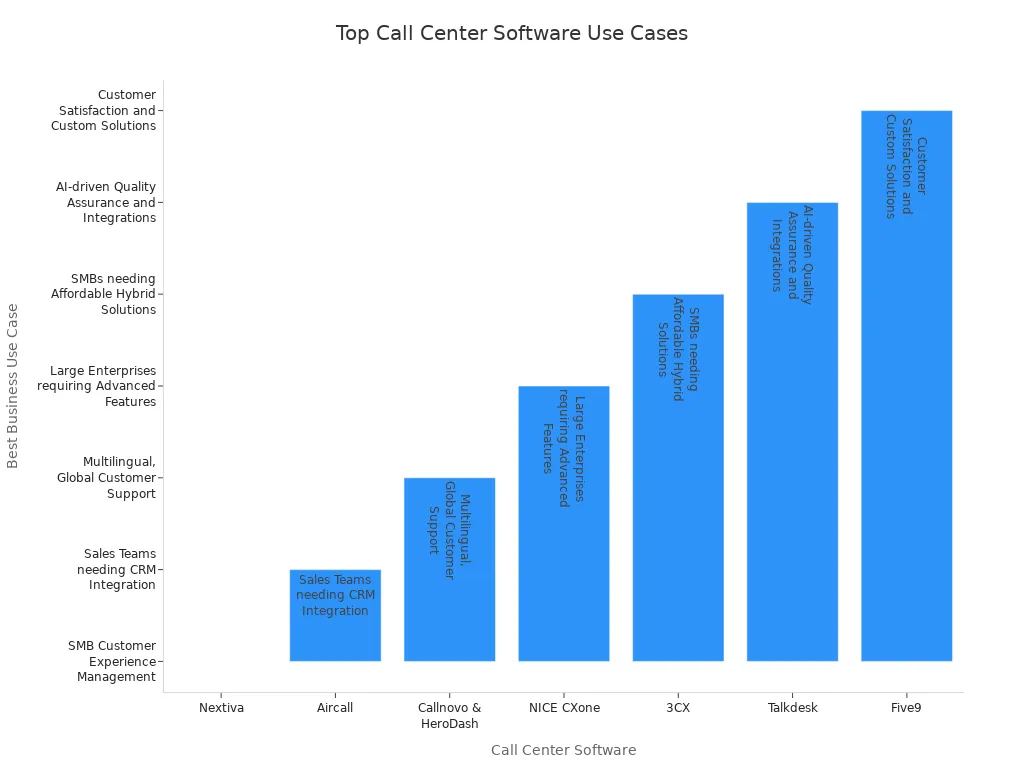
Businesses should analyze their needs and review insights from performance analytics before selecting a provider.
How to Choose the Right Call Center Solution
Assessing Business Needs
Selecting the right call center solution starts with a clear understanding of business needs. Companies should conduct a thorough assessment by analyzing current operations, customer expectations, and technology gaps. They need to address security and compliance requirements, such as PCI DSS or HIPAA, and ensure the solution offers call encryption and access controls. Scalability is vital for supporting growth, so businesses should look for flexible agent seats and the ability to expand into new regions. Customer experience metrics like first-call resolution, wait time management, and feedback mechanisms help drive satisfaction and customer retention. Companies should also plan for implementation, including system configuration and agent training. Prioritizing features such as AI integration, omnichannel support, and CRM integration enhances efficiency and workforce optimization.
Tip: Set clear objectives and define must-have features like auto-dialers, call recording, and analytics to boost agent performance and streamline operations.
Evaluating Demos and Support
A product demo provides valuable insight into how a solution addresses specific business challenges. Stakeholders should participate in demos to align expectations and gather feedback. During the demo, companies should observe how the platform handles real-world scenarios and ask questions to clarify doubts. Evaluating customer support is equally important. Businesses should consider the quality of onboarding, training, and ongoing support. Strong support models ensure smooth implementation and long-term satisfaction. After the demo, organizations should review unique selling points and plan for contract negotiation and continuous support.
Calculating ROI and Total Cost
Calculating ROI and total cost of ownership (TCO) involves more than comparing upfront prices. Companies must include all direct and indirect costs, such as licensing, implementation, training, maintenance, and hardware. Performance improvements should be measured using metrics like call volume, conversion rates, and customer satisfaction. Assigning monetary values to these gains helps justify investment. The ROI formula is: ROI = [(Net gains from investment – cost of investment) / cost of investment] x 100. Regular monitoring and optimization of ROI ensure the solution continues to support business growth and workforce optimization.
Note: Integration capabilities, scalability, and future trends like AI and omnichannel support play a crucial role in long-term success.
Top global call center solution providers deliver unique strengths in scalability, integration, and customer experience. Sobot stands out with its all-in-one omnichannel platform and AI-powered automation, supporting global enterprises across industries. Providers address modern needs by offering:
- Multi-channel support and cloud scalability for business growth.
- Integration with hundreds of apps to boost agent efficiency.
- AI-driven tools that improve customer satisfaction and reduce workload.
Matching call center software features to business goals and industry requirements ensures operational success. Readers should review the comparison table and selection guide before choosing the best solution for their needs.
FAQ
What is call center software?
Call center software helps businesses manage customer calls and messages. It connects agents with customers through phone, chat, email, and social media. Companies use it to improve service, track performance, and support customers worldwide.
How does omnichannel support improve customer experience?
Omnichannel support lets customers reach businesses on any channel they prefer. Agents see all conversations in one place. This approach reduces wait times and avoids repeating information, which leads to higher satisfaction.
Can call center solutions scale for global businesses?
Yes. Leading call center solutions offer cloud-based platforms. These platforms support multiple languages, time zones, and regions. Companies can add agents or channels as they grow, ensuring smooth operations worldwide.
What security features do top call center software providers offer?
Top providers use encryption, access controls, and compliance with standards like GDPR and PCI DSS. These features protect customer data and ensure privacy. Regular audits and secure data storage add extra layers of protection.
How does AI help in modern call center solutions?
AI automates routine tasks, such as answering common questions and routing calls. It provides real-time insights and helps agents respond faster. Businesses use AI to improve efficiency, reduce costs, and deliver better customer service.
See Also
Best Contact Center Technologies Evaluated For 2024
Leading Cloud-Based Contact Center Services Rated 2024
Best Remote Call Center Companies To Work For
